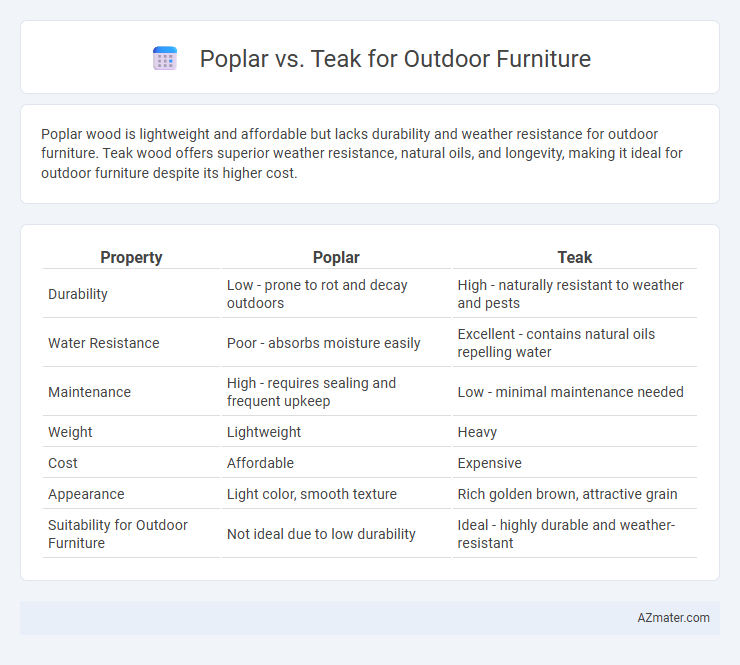Poplar wood is lightweight and affordable but lacks durability and weather resistance for outdoor furniture. Teak wood offers superior weather resistance, natural oils, and longevity, making it ideal for outdoor furniture despite its higher cost.
Table of Comparison
| Property | Poplar | Teak |
|---|---|---|
| Durability | Low - prone to rot and decay outdoors | High - naturally resistant to weather and pests |
| Water Resistance | Poor - absorbs moisture easily | Excellent - contains natural oils repelling water |
| Maintenance | High - requires sealing and frequent upkeep | Low - minimal maintenance needed |
| Weight | Lightweight | Heavy |
| Cost | Affordable | Expensive |
| Appearance | Light color, smooth texture | Rich golden brown, attractive grain |
| Suitability for Outdoor Furniture | Not ideal due to low durability | Ideal - highly durable and weather-resistant |
Introduction: Poplar vs Teak for Outdoor Furniture
Poplar and teak are two popular wood choices for outdoor furniture, each with distinct characteristics that influence durability and maintenance. Teak is renowned for its natural oils and dense grain, offering exceptional resistance to weather, rot, and insects, making it a premium option for long-lasting outdoor use. Poplar, while more affordable and lighter in weight, lacks the natural resilience of teak and may require protective treatments to withstand prolonged exposure to the elements.
Wood Characteristics: Poplar and Teak Compared
Poplar wood is lightweight with a fine, even grain, making it easy to work with but less durable and more prone to dents and moisture damage compared to teak. Teak wood is dense, oily, and highly resistant to rot, insects, and weathering, making it ideal for outdoor furniture that requires longevity and minimal maintenance. The natural oils in teak also provide a rich golden-brown color that improves with age, whereas poplar typically requires finishing and sealing for outdoor use.
Durability and Longevity in Outdoor Conditions
Poplar wood is generally less durable and more prone to rot and insect damage in outdoor conditions compared to teak, which is renowned for its natural oils that resist moisture, decay, and pests. Teak's dense grain and high oil content provide superior longevity, often lasting decades with minimal maintenance, making it ideal for outdoor furniture. Poplar requires protective coatings and more frequent upkeep to withstand exposure, whereas teak can endure harsh weather with natural resilience.
Resistance to Weather, Moisture, and Pests
Teak wood offers superior resistance to weather, moisture, and pests, making it highly durable for outdoor furniture due to its natural oils that repel water and insects. Poplar, however, is less resistant to these elements and tends to absorb moisture easily, leading to quicker deterioration and vulnerability to pests. For outdoor use, teak's longevity and low maintenance requirements significantly outperform poplar, which is better suited for indoor furniture.
Maintenance Requirements: Poplar vs Teak
Poplar requires more frequent maintenance compared to teak due to its softer wood structure, which makes it more susceptible to dents, scratches, and weathering when used outdoors. Teak contains natural oils and a dense grain, providing superior resistance to moisture, pests, and decay, significantly reducing the need for sealing or treatment. Regular cleaning and occasional oiling are typically sufficient to maintain teak's durability and appearance, whereas poplar demands protective coatings and more intensive upkeep to prevent damage and prolong its lifespan.
Environmental Impact and Sustainability
Poplar wood is a fast-growing hardwood with a lower environmental impact due to its rapid renewability and ability to sequester carbon quickly, making it a sustainable option for outdoor furniture. In contrast, teak is a slow-growing tropical hardwood known for its durability and resistance to weather, but its harvesting often contributes to deforestation and habitat loss, raising sustainability concerns. Choosing poplar supports eco-friendly practices by reducing deforestation pressure, while teak requires certification like FSC to ensure responsible sourcing.
Cost Comparison: Poplar Furniture vs Teak Furniture
Poplar furniture generally costs significantly less than teak furniture due to its faster growth rate and greater availability, making it a budget-friendly option for outdoor settings. Teak furniture commands a higher price because of its natural oils, durability, and resistance to weather, which contribute to its long lifespan and low maintenance requirements. Choosing poplar can reduce upfront expenses but may lead to higher replacement costs, whereas teak offers lasting value despite the initial investment.
Aesthetics: Appearance and Finishing Options
Poplar offers a light, creamy color with a smooth grain, making it ideal for painting and staining to achieve various finishes, while teak boasts a rich golden-brown hue with natural oils that enhance its aging into a desirable silver-gray patina. Teak's dense grain and oily texture provide superior resistance to weathering and allow for a natural, polished look with minimal maintenance, whereas poplar's softer wood requires more protective coatings to maintain its appearance outdoors. Both woods can be finished to suit different design styles, but teak's luxurious aesthetic and durability make it a preferred choice for high-end outdoor furniture.
Best Uses and Recommendations for Each Wood
Poplar, known for its lightweight and affordability, is best used for painted outdoor furniture where moisture exposure is limited, as it is less resistant to rot and decay. Teak, valued for its natural oils and dense grain, excels in high-moisture environments, making it ideal for durable, weather-resistant outdoor furniture like garden benches and patio sets. For long-lasting outdoor use, teak is recommended when exposure to elements is constant, while poplar suits covered or occasional outdoor settings.
Conclusion: Choosing the Right Wood for Outdoor Furniture
Poplar offers affordability and ease of working with but lacks the natural durability and weather resistance essential for long-lasting outdoor furniture, unlike teak. Teak's high oil content and dense grain structure provide superior resistance to moisture, decay, and insects, making it the preferred choice for outdoor environments. Investing in teak ensures longevity and minimal maintenance, while poplar may be better suited for indoor or protected outdoor furniture.

Infographic: Poplar vs Teak for Outdoor Furniture
 azmater.com
azmater.com